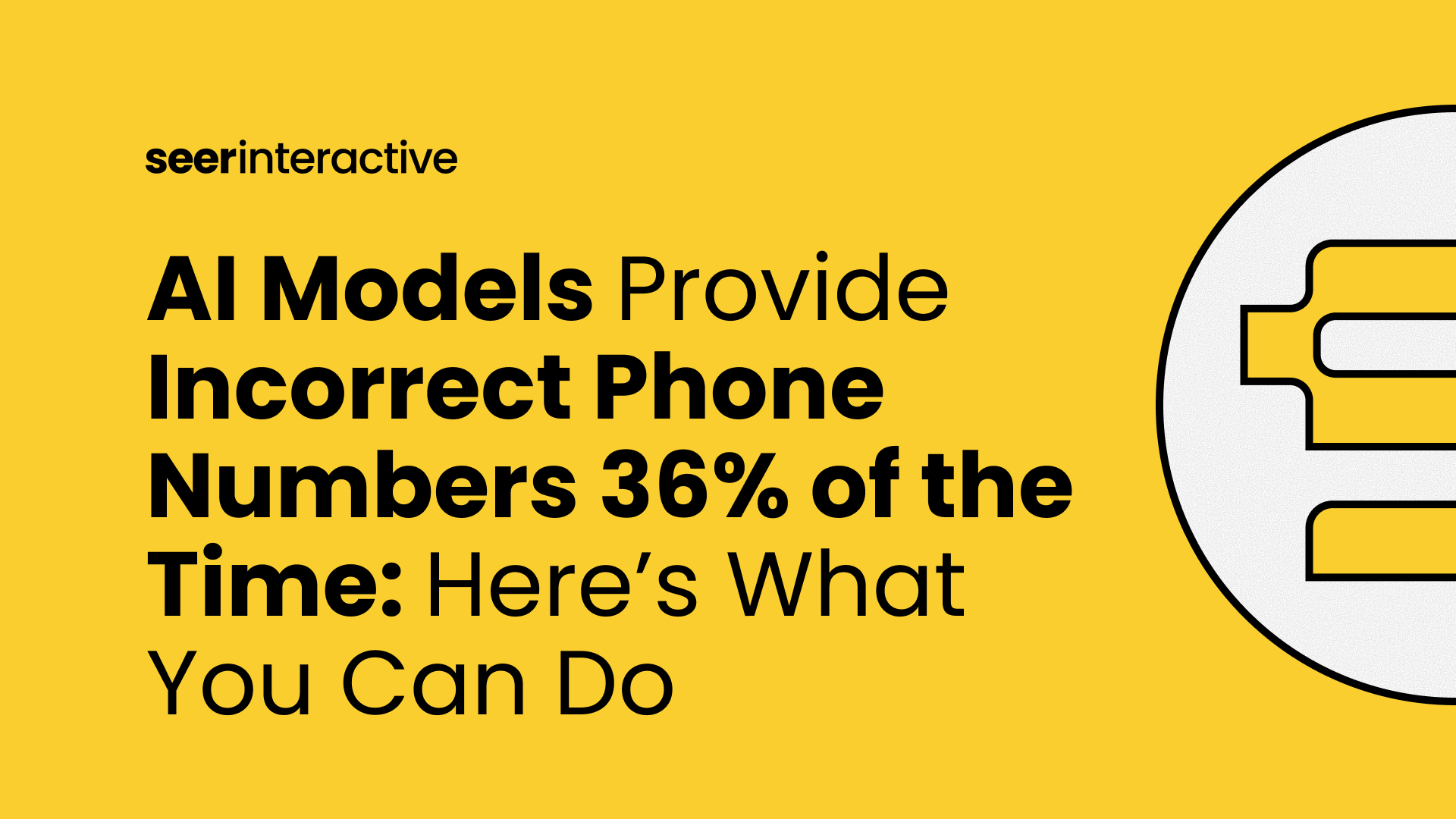The search landscape is rapidly changing in 2024. We are long past the time of ‘ten blue links’ and are in an era where the average consumer has more possible digital touchpoints on their buying journey than ever before. As consumers, this is a great thing. As marketers, this is a layer of complexity that few are truly ready for.
The diversification of platforms involved in the buyer’s journey requires an innovative approach to setting and executing a marketing strategy. Many of these new touch points don’t give us access to the data we’re accustomed to. We’re used to seeing brands subject to both negative and positive user generated content on social media. We’re less used to seeing this on search engines. While featured snippets have long provided ‘instant answers,’ these snippets were pulled from a source - not created in real time.
Many marketing executives have the same questions:
- Is our brand (or our competitors) mentioned in non-branded searches about our product or service on AI search engines?
- How can we track misinformation about our brand on AI search engines?
- What are the AI chatbots saying about our brand?
- How important are AI chatbots in our buyer’s journey?
- Do we need a new strategy for AI search engines?
- How is Search Generative Experience (SGE) going to change our ability to drive traffic from Google search?
While much remains to be seen as this new technology evolves, marketers need to be able to answer these questions today with the information we have available.
To that end, we’ve aligned on three basic tactics that can help.
Robust Referral Monitoring
Starting with the data gives us a good foundation to solve most problems, and this is no exception. To answer the questions above, one needs to consider their approach to tracking impressions, referral traffic, and website engagement via these new sources.
Here’s a basic overview for how to track critical search metrics across AI search engines and chatbots:
|
How to track… |
|||
|
Platform |
Impressions |
Traffic |
Site Engagement |
|
ChatGPT |
GPT for Sheets |
AI Search Traffic Dashboard |
AI Search Traffic Dashboard |
|
Google Gemini |
Manual Collection, if priority |
AI Search Traffic Dashboard |
AI Search Traffic Dashboard |
|
Bing Copilot |
GPT for Sheets (directionally) |
AI Search Traffic Dashboard |
AI Search Traffic Dashboard |
|
Google SGE |
Manual Collection, if priority |
N/A |
N/A |
|
Perplexity.ai |
Manual Collection, if priority |
AI Search Traffic Dashboard |
AI Search Traffic Dashboard |
We were the first to market with a solution for how to track brand visibility on ChatGPT with this post from May 2023. Unfortunately for marketers, not much has changed since then in terms of availability of better tools. On the bright side, our template and approach is free for all to use.
My recommendation is to start with a baseline of 10-20 priority keywords to collect Impression data for. If you have the resources or budget, it’s not a bad idea to work with a platform like Fiverr to pull this data manually on a recurring basis.
Remember, we cannot optimize what we cannot measure, and keyword tracking is a critical component of measurement for SEO.
Establishing ‘when to care’ thresholds is equally important as collecting data. We need to understand what we’re measuring for and why. Here are some qualitative and quantitative ways organizations may set ‘when to care’ thresholds:
- A significant portion of referral traffic is being driven to pages that are part of your buyer's journey. Defining significance will vary, but I would venture that if you are seeing 5-10% of your traffic coming from these sources, it’s time to care.
- There are questionable or erroneous statements being made about your brand in your initial benchmark of branded impressions.
- You’ve heard first hand from a significant number of prospects and customers that these platforms were a part of their buying journey, and they saw something in these platforms that influenced their purchase decision.
Following the steps above should arm you to react well to questions from your c-suite about these platforms, which is a great step.
Next, we want to understand how to proactively monitor this data to influence strategy.
Monitor the data for significance on a recurring basis and report back to all stakeholders. Within that reporting, we should reference the thresholds we are monitoring for as well as the actions we’ll recommend if/when the threshold is reached. Those actions may include:
- Shift budget or resources from one channel / initiative to focus on new digital entry points. Marketing leaders should be ready to give an informed recommendation for which channel / initiative to deprioritize.
- Prepare executive communication that cautions your c-suite to be prepared for a shift in performance from previously high yielding channels.
- Create recommendations for short term and long term tactics we’ll deploy to attempt to recoup performance.
You may be wondering, what short term and long term tactics can one deploy to influence AI platforms? This is where SEOs can prosper. We have a long history of reverse engineering algorithms and monitoring official communication for tips and clues used to influence ranking on digital platforms. Work with the data you’ve collected, assemble hypotheses, and test to prove / disprove your beliefs.
Moderated User Research
In addition to quantitative data, performing moderated user research can give you objective insights of how your audience engages with new platforms. At Seer, we have uncovered highly valuable insights by watching users perform searches, review SERPs, and talk through their thought process. This process is powerful, but should be conducted by those specialized in running moderated sessions in an unbiased and statistically significant manner.
Here are some questions that can be answered with moderated user research:
- Where do you start your search journey?
- Are some platforms more or less influential to your ultimate decision?
- When engaging with Chatbots, what does the conversation flow look like? What query do you start with, and how do you engage the Chatbot further to continue to source information?
- How does your search journey connect and resonate with the user experience of (insert your website)?
- If those experiences are disconnected, what are the main ways this is felt?
These insights can prove incredibly valuable, and give you reason to believe that these platforms are a priority to monitor and attempt to influence long before they show up in your Analytics.
Equally important to your insights collected about AI platforms is the role of traditional search engines in the buyer’s journey. You may hear some very interesting tidbits about clever things your audience does with AI chatbots, but ultimately traditional search will likely still be the main catalyst of their decision making.
Check out this resource for more information on how we conduct moderated user testing at Seer.
One Strategy to Rule Them All
If you have followed step one and two, you may find yourself with a validated belief that these platforms are influential in your customers’ buying journey. The obvious question then becomes: What do we do about it?
This is perhaps the most important question digital marketers will seek to answer in 2024. There are many threads to pull on and hypotheses to test and learn from. This is the point in which it likely makes sense to bring in a professional. In lieu of working with us directly to help answer this question, I’ll leave you with some initial direction.
Overall, your marketing strategy should be holistic and encompassing of all channels and points in the buyers’ journey. These new platforms represent the need for new tactics, but not likely a new strategic direction. To that end, the tenants of SEO that we follow at Seer ring true for these AI platforms as well.
- Creating a great user experience remains critical. Use insights driven from your moderated user research and the data you’re collecting to ensure you are answering the questions that your audience has about your product or service.
- Your website must be accessible in order to be in the conversation. If you are blocking ChatGPT from crawling your site, you’re eliminating your ability for your site to be mentioned via Retrieval Augmented Generation. If your site has great content but poor crawlability, you’re severely limiting how much of your first party content about your brand can be incorporated within the training corpuses for LLMs.
- Your content should be unique, valuable, and offer multimodality. Multimodality has been a hot topic for AI platforms and will become more of a focus in 2024. Creating content in the mediums that your audience is seeking should increase your likelihood to be a part of that audience’s buying journey.
- Your brand should be mentioned and discussed on the mediums your audience engages with. This post by Sandi Griffin about optimizing your website for branded AI chat results is a great primer. Additionally, marketers should take note of the sources included in the Common Crawl dataset, as well as the other sources included in training set corpuses for LLMs.
These three ideas represent a short list but a large volume of tasks. It can feel overwhelming to pursue so many unknown entities. Take solace in the fact that all marketers are struggling with these questions now, and we are all in this together. We are active on LinkedIn at Seer and invite you to continue the conversation there.


